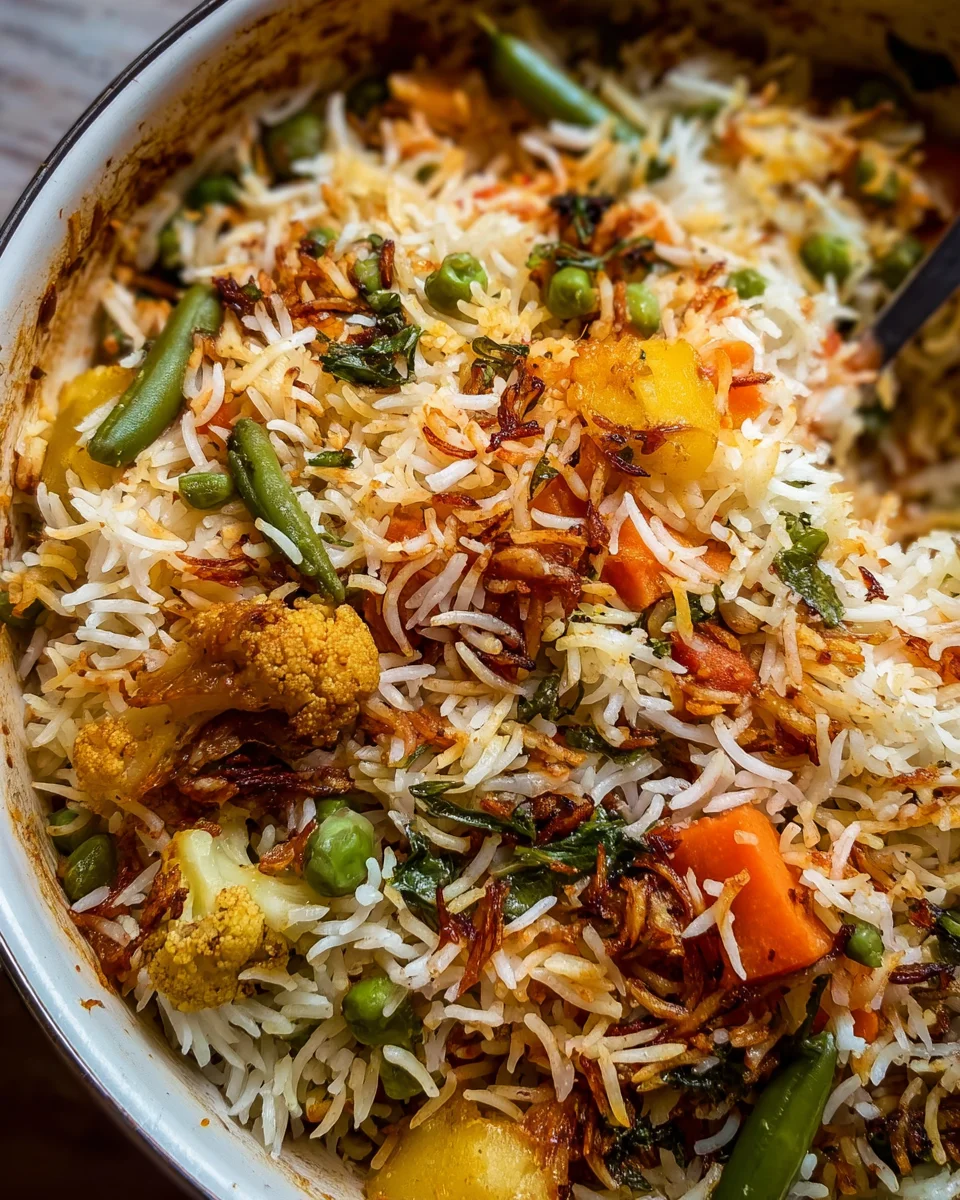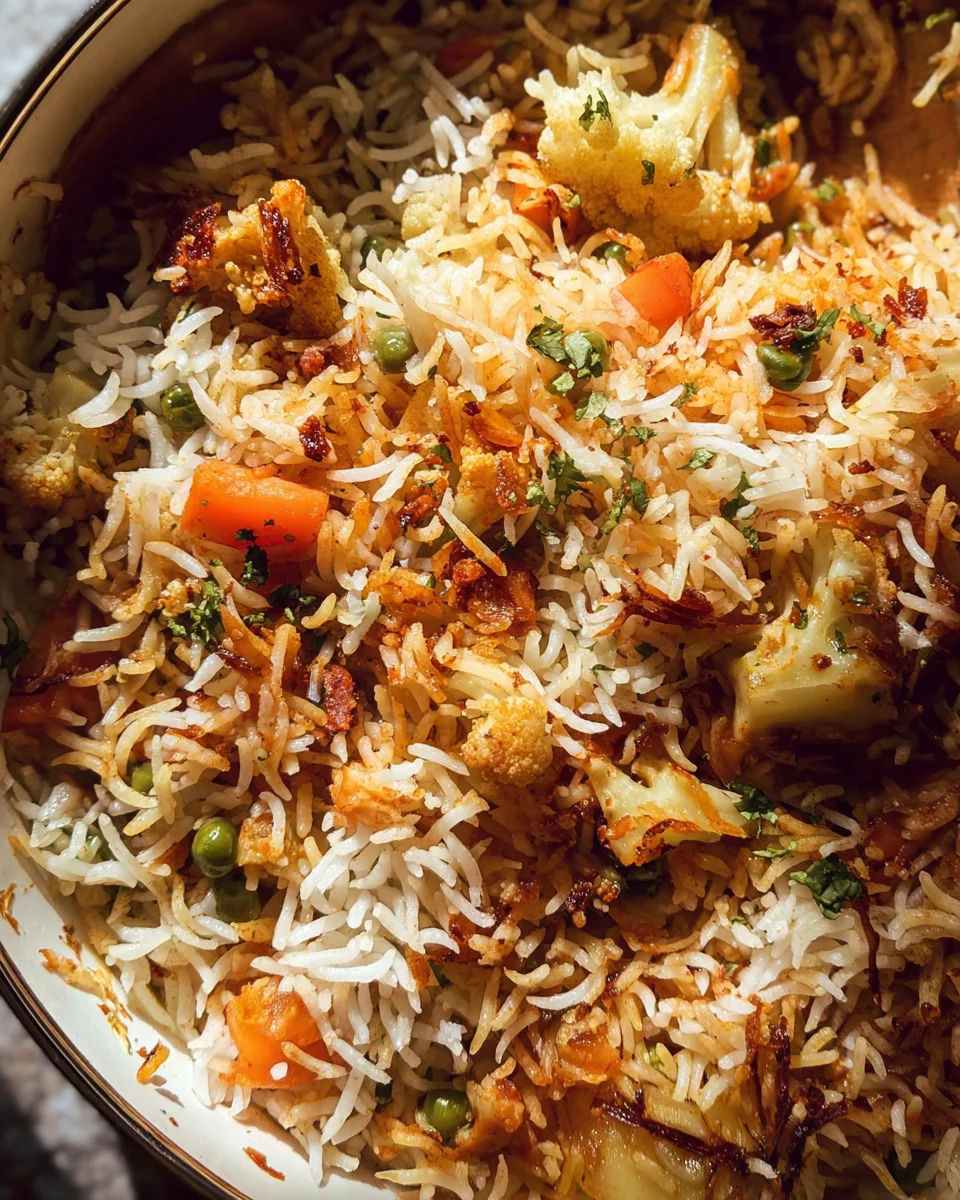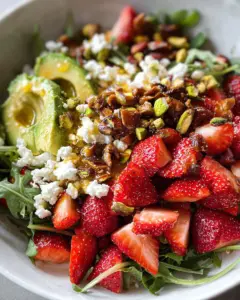Aromatic and flavorful restaurant style Vegetable Biryani is the perfect dish for any occasion. This vibrant biryani is a delightful mix of fresh vegetables, aromatic spices, and fragrant herbs. Each bite delivers an explosion of flavors, making it a favorite for gatherings, celebrations, or a cozy family dinner. Whether you’re serving it as the main course or alongside your favorite raita, this dish is sure to impress.

Jump to:
- Why You’ll Love This Recipe
- Tools and Preparation
- Essential Tools and Equipment
- Importance of Each Tool
- Ingredients
- Rice & Aromatics
- Ghee & Vegetables
- Dairy & Spices
- Oils & Seasonings
- Yogurt & Masalas
- Final Touches
- How to Make Restaurant Style Vegetable Biryani
- Step 1: Prepare the Rice
- Step 2: Sauté the Aromatics
- Step 3: Cook Vegetables
- Step 4: Add Spices
- Step 5: Combine Rice with Vegetables
- Step 6: Add Liquid
- Step 7: Cook on Low Heat
- Step 8: Final Touches
- How to Serve Restaurant Style Vegetable Biryani
- With Raita
- Accompanied by Salads
- Pairing with Pickles
- Adding Crispy Elements
- Serving with Sweets
- How to Perfect Restaurant Style Vegetable Biryani
- Best Side Dishes for Restaurant Style Vegetable Biryani
- Common Mistakes to Avoid
- Storage & Reheating Instructions
- Refrigerator Storage
- Freezing Restaurant Style Vegetable Biryani
- Reheating Restaurant Style Vegetable Biryani
- Frequently Asked Questions
- What is the secret to making fluffy biryani?
- Can I make Restaurant Style Vegetable Biryani vegan?
- How do I enhance the flavors of my biryani?
- What can I serve with Vegetable Biryani?
- Final Thoughts
- 📖 Recipe Card
Why You’ll Love This Recipe
- Easy to Prepare: With simple steps and accessible ingredients, making restaurant style Vegetable Biryani at home is easier than you think.
- Packed with Flavor: A combination of spices and fresh herbs creates a vibrant taste that rivals any restaurant version.
- Versatile Dish: Suitable for vegetarians and vegans alike, this biryani can be enjoyed by everyone at the table.
- Perfect for Meal Prep: Make a large batch for the week ahead; it reheats beautifully without losing its flavor.
- Impressive Presentation: The colorful vegetables and fragrant saffron make this dish visually stunning.
Tools and Preparation
Before diving into making your restaurant style Vegetable Biryani, gather all necessary tools to streamline your cooking process.
Essential Tools and Equipment
- Heavy-bottomed pot
- Wooden spoon
- Knife
- Cutting board
- Measuring cups and spoons
Importance of Each Tool
- Heavy-bottomed pot: Prevents rice from burning while evenly distributing heat for perfect cooking.
- Wooden spoon: Ideal for stirring ingredients without scratching your cookware.
- Knife: A sharp knife makes chopping vegetables safe and efficient.
Ingredients
Aromatic and flavorful restaurant style Vegetable Biryani! This fragrant biryani is packed with veggies, spices, herbs and nuts and is an explosion of flavors in every bite!
Rice & Aromatics
- 1 cup basmati rice (200 grams, soaked in 3 cups (24 oz) water for 30 minutes)
- 6 whole green cardamom (divided)
- 4 cloves (divided)
- 1 teaspoon salt (divided)
Ghee & Vegetables
- 1.5 tablespoon +1 teaspoon ghee (divided)
- 2 medium red onion (thinly sliced, divided)
- 2 tablespoons broken cashews
- 1 small potato (cubed)
- 1/2 cup cauliflower florets (medium sized florets)
- 1 medium carrot (cut diagonally)
- 5-6 green beans (cut diagonally)
Dairy & Spices
- 2 tablespoons milk (30 ml)
- saffron strands (generous pinch)
- 1 inch ginger (crushed)
- 4-5 large garlic cloves (crushed)
- 2 green chilies (crushed)
Oils & Seasonings
- 1.5 tablespoons oil (22 ml)
- 1/2 teaspoon cumin seeds (I used shahi jeera)
- 1 inch cinnamon stick
- 1 bay leaf
- 3 whole black peppercorns
Yogurt & Masalas
- 1/3 cup plain yogurt (whisked at room temperature, can add 1/4 teaspoon cornstarch to prevent curdling)
- 1.5 teaspoon biryani masala (or use 1 teaspoon garam masala)
- 1/2 teaspoon kashmiri red chili powder (or regular chili powder for heat)
Final Touches
- 1/4 cup water
- 2 tablespoons chopped cilantro
- 2 tablespoons chopped mint
- 1.5 teaspoon rose water or kewra water
How to Make Restaurant Style Vegetable Biryani
Step 1: Prepare the Rice
First, soak the basmati rice in water for about 30 minutes. Drain the rice before cooking to remove excess starch.
Step 2: Sauté the Aromatics
In a heavy-bottomed pot, heat 1 tablespoon of ghee over medium heat. Add half of the sliced onions and sauté until golden brown. Reserve some fried onions for garnishing later.
Step 3: Cook Vegetables
Add cubed potato, cauliflower florets, carrot pieces, and green beans to the pot. Stir well and cook until slightly tender.
Step 4: Add Spices
Now add crushed ginger, garlic, green chilies, cardamom pods, cloves, cumin seeds, cinnamon stick, bay leaf, black peppercorns, salt, and broken cashews. Stir continuously to release flavors.
Step 5: Combine Rice with Vegetables
Gently fold in the soaked basmati rice into the vegetable mixture. Add biryani masala and Kashmiri red chili powder. Mix well but do not break the rice grains.
Step 6: Add Liquid
Pour in yogurt mixed with milk and saffron strands dissolved in warm water. Add an additional ¼ cup of water if needed. Cover tightly with a lid.
Step 7: Cook on Low Heat
Reduce heat to low and let it cook for about 25-30 minutes until rice is fluffy and fully cooked through.
Step 8: Final Touches
Once done cooking, fluff the rice gently with a fork. Garnish with chopped cilantro, mint leaves, fried onions, and drizzle rose water or kewra water on top before serving.
Enjoy your homemade restaurant style Vegetable Biryani!
How to Serve Restaurant Style Vegetable Biryani
Serving Restaurant Style Vegetable Biryani is an art that enhances its rich flavors and aromas. Here are some delightful serving suggestions to elevate your dining experience.
With Raita
- Cucumber Raita: A cooling yogurt dip with grated cucumber that balances the spice of the biryani.
- Mint Raita: Made with fresh mint, this raita adds a refreshing taste that complements the biryani.
Accompanied by Salads
- Kachumber Salad: A mix of diced cucumbers, tomatoes, and onions drizzled with lemon juice for a zesty crunch.
- Onion Salad: Thinly sliced onions with a sprinkle of lemon enhance the flavors of the biryani.
Pairing with Pickles
- Mango Pickle: This tangy pickle brings a wonderful contrast to the savory biryani.
- Lemon Pickle: Adds a citrusy punch that lifts the overall flavor profile.
Adding Crispy Elements
- Papadums: These crispy lentil wafers offer a delightful crunch when enjoyed alongside the soft biryani.
- Fried Onions: Sprinkle some on top for added texture and flavor.
Serving with Sweets
- Gulab Jamun: These sweet, syrup-soaked dumplings provide a perfect end to a spicy meal.
- Kheer: This creamy rice pudding offers a soothing finish after enjoying flavorful biryani.

How to Perfect Restaurant Style Vegetable Biryani
To achieve the best results while making your Restaurant Style Vegetable Biryani, consider these helpful tips.
- Use Quality Rice: Opt for aged basmati rice for better flavor and texture during cooking.
- Soak Rice Properly: Soaking helps in achieving fluffy grains that don’t stick together.
- Layer Ingredients Wisely: Layering vegetables, spices, and rice ensures even cooking and enhances flavors.
- Control Heat Levels: Cook on low heat after layering; this allows the flavors to meld without burning.
- Add Aromatics at Right Time: Include saffron and rose water towards the end for an aromatic finish.
- Let it Rest Before Serving: Allowing biryani to rest helps in settling flavors and makes it easier to serve.
Best Side Dishes for Restaurant Style Vegetable Biryani
Pairing side dishes with your Restaurant Style Vegetable Biryani can elevate your meal. Here are some excellent options:
- Cucumber Raita – A cool yogurt blend that refreshes the palate between bites of spicy biryani.
- Mixed Green Salad – A light salad with greens adds freshness and crunch, balancing the richness of the dish.
- Pappadam – Crispy lentil wafers that provide textural contrast to the soft biryani.
- Mango Chutney – Sweet and tangy chutney that complements the savory notes in biryani beautifully.
- Roasted Vegetables – Seasonal roasted veggies add color and nutrition to your plate while echoing biryani’s flavors.
- Pickled Onions – Sharp pickled onions cut through richness and add brightness to every bite.
- Paneer Tikka – Grilled marinated paneer cubes offer a delicious protein-packed accompaniment.
- Gulab Jamun – End your meal on a sweet note with these luscious Indian desserts; they balance out spicy meals perfectly.
Common Mistakes to Avoid
Cooking Restaurant Style Vegetable Biryani can be delightful, but there are common pitfalls that can turn this dish into a disaster. Here are some mistakes to avoid:
- Skipping the soaking step – Not soaking basmati rice can lead to uneven cooking. Soak the rice for at least 30 minutes before cooking for perfect texture.
- Overcrowding the pot – Adding too many vegetables at once can result in uneven cooking and mushiness. Cook in batches to maintain the right consistency.
- Ignoring spice balance – Too many spices can overwhelm the dish. Use the recommended amounts and adjust based on your taste preference.
- Not using fresh herbs – Old or dried herbs do not impart the same flavor. Always use fresh cilantro and mint for an aromatic biryani.
- Neglecting proper layering – Failing to layer rice and vegetables properly can lead to a mixed-up dish. Layer carefully for optimal flavor distribution.

Storage & Reheating Instructions
Refrigerator Storage
- Store leftover Restaurant Style Vegetable Biryani in an airtight container.
- It can last up to 3-4 days in the refrigerator.
Freezing Restaurant Style Vegetable Biryani
- Freeze leftovers in a freezer-safe container or zip-lock bag.
- It will keep well for up to 2 months.
Reheating Restaurant Style Vegetable Biryani
- Oven – Preheat to 350°F (175°C) and cover with foil. Heat for 15-20 minutes until warmed through.
- Microwave – Place in a microwave-safe bowl, cover, and heat in intervals of 1-2 minutes, stirring in between.
- Stovetop – Add a splash of water to the biryani in a pan, cover, and heat over low flame, stirring occasionally.
Frequently Asked Questions
Here are some frequently asked questions about making Restaurant Style Vegetable Biryani that may help you perfect your dish.
What is the secret to making fluffy biryani?
The key is to soak the basmati rice properly and avoid overcrowding during cooking. This helps each grain remain separate and fluffy.
Can I make Restaurant Style Vegetable Biryani vegan?
Yes! Simply replace ghee with vegetable oil and ensure any dairy ingredients like yogurt are plant-based.
How do I enhance the flavors of my biryani?
Incorporating fresh herbs like cilantro and mint, along with quality spices, enhances the overall flavor profile. Adding saffron also adds depth.
What can I serve with Vegetable Biryani?
Pair your Restaurant Style Vegetable Biryani with raita (yogurt sauce), salad, or even papadam for a complete meal experience.
Final Thoughts
This Restaurant Style Vegetable Biryani is not only delicious but also versatile. You can customize it by adding your favorite vegetables or adjusting spices according to your preference. Try this amazing recipe today and enjoy an explosion of flavors!
Did You Enjoy Making This Recipe? Please rate this recipe with ⭐⭐⭐⭐⭐ or leave a comment.
📖 Recipe Card
Print
Restaurant Style Vegetable Biryani
- Total Time: 45 minutes
- Yield: Serves 4
Description
Restaurant Style Vegetable Biryani is a vibrant and aromatic dish that brings a taste of Indian cuisine right to your kitchen. This delightful one-pot meal features fluffy basmati rice layered with an array of fresh vegetables, aromatic spices, and fragrant herbs. Each bite is a burst of flavors, making it perfect for family dinners, celebrations, or gatherings.
Ingredients
- 1 cup basmati rice
- 2 medium red onions
- 1 small potato
- 1/2 cup cauliflower florets
- 1 medium carrot
- 5–6 green beans
- Spices: cardamom, cloves, cumin seeds, cinnamon stick
- Ghee or oil
- Plain yogurt
- Fresh cilantro and mint
Instructions
- Soak basmati rice in water for 30 minutes, then drain.
- In a heavy-bottomed pot, heat ghee and sauté half of the sliced onions until golden brown.
- Add cubed potato, cauliflower florets, carrot pieces, and green beans; cook until tender.
- Stir in crushed ginger, garlic, green chilies, and spices; cook until fragrant.
- Gently fold in the soaked rice along with biryani masala and chili powder.
- Pour yogurt mixed with saffron strands dissolved in warm water over the mixture.
- Cover and cook on low heat for about 25-30 minutes until rice is fluffy.
- Prep Time: 15 minutes
- Cook Time: 30 minutes
- Category: Main
- Method: Cooking
- Cuisine: Indian
Nutrition
- Serving Size: 1 cup (200g)
- Calories: 320
- Sugar: 4g
- Sodium: 450mg
- Fat: 12g
- Saturated Fat: 5g
- Unsaturated Fat: 7g
- Trans Fat: 0g
- Carbohydrates: 45g
- Fiber: 4g
- Protein: 8g
- Cholesterol: 15mg





